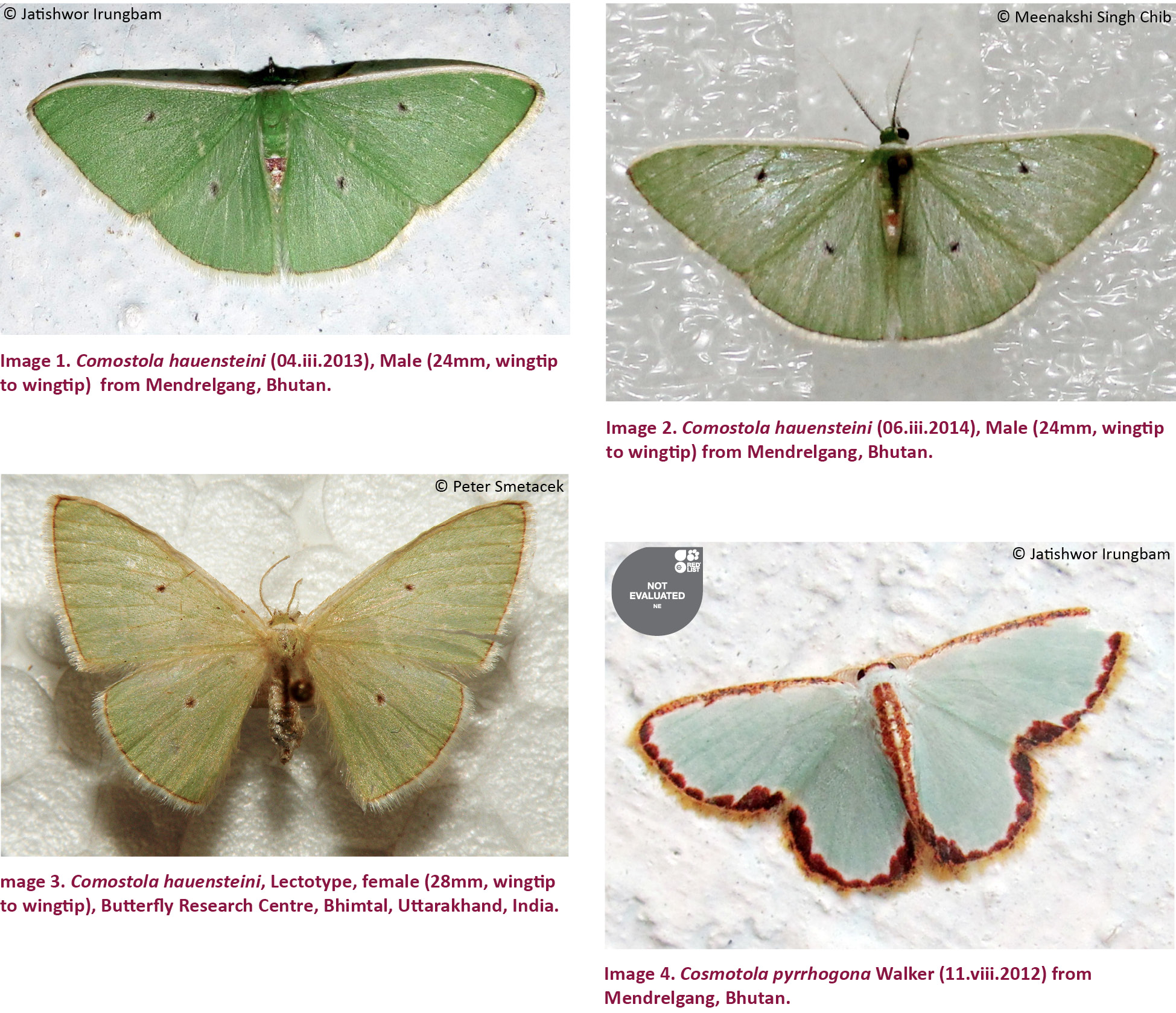A new range record of Comostola hauensteini Smetacek, 2004 (Lepidoptera: Geometridae: Geometrinae) from Bhutan
Irungbam Jatishwor Singh
Mendrelgang Middle Secondary School, Mendrelgang, Tsirang District 36001, Bhutan
jatishwor.irungbam@gmail.com
doi: http://dx.doi.org/10.11609/JoTT.o3988.7302-4 | ZooBank: urn:lsid:zoobank.org:pub:9796577A-1C70-40D3-A06D-7060D4CC94A2
Editor: Ullasa Kodandaramaiah, IISER-TVM, Thiruvananthapuram, India. Date of publication: 26 May 2015 (online & print)
Manuscript details: Ms # o3988 | Received 05 April 2014 | Final received 14 February 2015 | Finally accepted 18 April 2015
Citation: Singh, I.J. (2015). A new range record of Comostola hauensteini Smetacek, 2004 (Lepidoptera: Geometridae: Geometrinae) from Bhutan. Journal of Threatened Taxa 7(6): 7302–7304; http://dx.doi.org/10.11609/JoTT.o3988.7302-4
Copyright: © Singh 2015. Creative Commons Attribution 4.0 International License. JoTT allows unrestricted use of this article in any medium, reproduction and distribution by providing adequate credit to the authors and the source of publication.
Funding: None.
Competing Interest: The author declares no competing interests.
Acknowledgements: The author is thankful to Mr. Dorji Wangchuk, Ex-Principal and Mr. Chaxing Norbu, Principal, Mendrelgang Middle Secondary School for providing necessary support and facilities during the study. The author is also thankful to Mr. Peter Smetacek, Butterfly Research Centre, Bhimtal, Uttarakhand for his guidance and suggestions during the identification of specimens and for providing the photographs of the holotype and paratype of the species. Also, I would like to express my sincere gratitude to Ms. Meenakshi Singh Chib, teacher, Mendrelgang Middle Secondary School for her specimen’s photo and help rendered during the preparation of manuscript.

The genus Comostola Meyrick is widely distributed in Indo-Australian tropics and subtropics. Typical Comostola are pale blue-green or green with red-orange discal spots and punctate yellow, red or orange postmedial spots. The distal margins in many species are lined finely with red, broken at the veins, the fringes being paler. This group has the discal cross-veins of the forewing cell characteristically stepped towards the margin, proceeding it towards the dorsum (Holloway 1996).
Materials and Methods: The observations in this paper are part of an ongoing Lepidoptera survey in the Mendrelgang division (27002’N & 90010’E, 1035m) conducted by the Department of Science, Mendrelgang Middle Secondary School since January 2011. The methodology adopted for the moth survey was visual encounter survey on the whitewashed walls of the residential areas and in the school campus between 20:00–06:00 hr. accompanied by photo-documentation of moths. Moth traps were also set up in different locations of Mendrelgang using white cloth and 20 watt fluorescent bulbs and mercury vapor lamps. Voucher specimens for the species which could not be identified in the field were collected, later sorted out and deposited at the Department of Science, Mendrelgang Middle Secondary School, Tsirang (Bhutan).
Observations and Discussion: During the survey, C. hauensteini was encountered a couple of times. A single male was sighted on 04 March 2012 at 23:27hr. on the whitewashed wall of the author’s quarters in the premises of Mendrelgang Middle Secondary School, Tsirang District, Bhutan on which a 20 watt fluorescent bulb was switched on overnight. The specimen was photographed but not collected (Image 1). Later this specimen was identified as C. hauensteini by Peter Smetacek, Butterfly Research Center, Bhimtal. Later, on 06 March 2014 at 05:35hr a single male was sighted again on the wooden door of the Department of Science, Mendrelgang Middle Secondary School where a 100 watt tungsten lamp was switched on overnight (Image 2). The specimen was collected as a voucher specimen; a photograph of the curated specimen was sent to Peter Smetacek and he confirmed that the specimen was a C. hauensteini.

The species C. hauensteini was described by Peter Smetacek in 2004 from Bhimtal Valley (29020’41’’N & 79036’17’’E) in Nainital District in Uttarakhand. The type series of C. hauensteini comprised a holotype male and paratype female captured from Bhimtal (Image 3). This species is distinguished from other species of Comostola by the vertex of the head being green, frons and palpi white. Antennae of male, pale brown, bipectinate to two-thirds the length and rami long. Collar is white and thorax pale green, abdomen with first segment dorsally green and rest of the abdomen shining white and legs are white. This species can be immediately distinguished from the other known members of the genus by the prominent white forewing costa (Smetacek 2004). A review of the literature reveals that the species has neither been reported from the Indian sub-region nor any other localities of the Himalaya (Chandra 2007; Chandra & Sambath 2013). The present record extends the known distribution of C. hauensteini to the eastern Himalaya. It thus represents a significant range extension for the species.

Other species of the genus Comostola which are reported from the Indian sub-region are given in Table 1, of which Comostola pyrrhogona Walker, 1866 (Image 4) was also reported and sighted very regularly from the study area during the survey; this is also a new record for Bhutan, as it was not reported from Bhutan previously.
References
Chandra, K. (2007). Moth diversity of Madhya Pradesh and Chattisgarh, India, and its conservation measures, pp. 49–61. In: Kendrick, R.C. (ed.). Proceedings of the First South East Asian Lepidoptera Conservation Symposium, Hong Kong 2006. Kadoorie Farm & Botanical Garden, Hong Kong
Chandra, K. & S. Sambath (2013). Moth diversity of Tawang District, Arunachal Pradesh, India. Journal of Threatened Taxa 5(1): 3565–3570; http://dx.doi.org/10.11609/JoTT.o2718.966
Holloway, J.D. (1996). The moths of Borneo (part 9); Family Geometridae: Subfamilies Oenochrominae, Desmobathrinae, Geometrinae. Malayan Nature Journal 49: 147–326.
Smetacek, P. (2004). Description of new Lepidoptera from the Kumaon Himalaya. Journal of Bombay Natural History Society 101(2): 269–276.